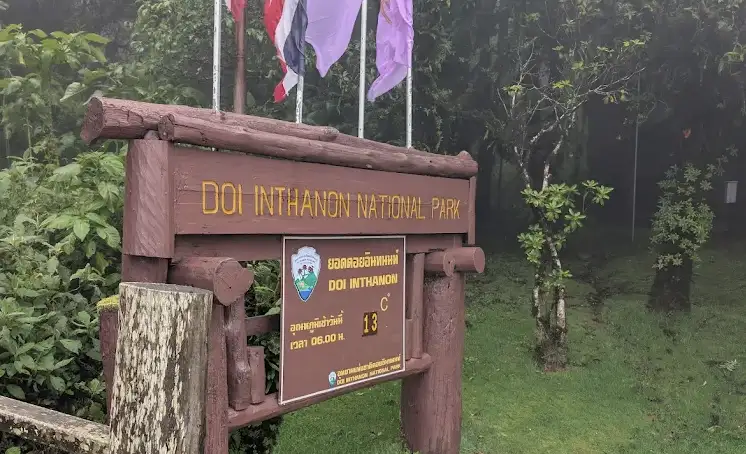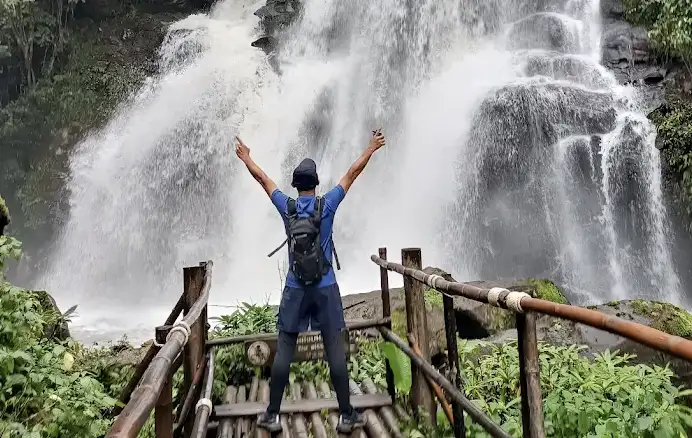Table of Contents
Nestled in the heart of Chiang Mai Province, Doi Inthanon National Park is a gem that every nature lover, adventure seeker, and curious traveler should have on their radar. Often referred to as the “Roof of Thailand,” this national park is home to the country’s highest peak, standing at 2,565 meters above sea level. My recent trip to Doi Inthanon was nothing short of magical, filled with breathtaking landscapes, cool mountain air, and a sense of serenity that’s hard to find elsewhere. Here’s my honest and heartfelt review of my experience, from misty trails to vibrant local culture, with tips to help you make the most of your visit.
Getting There: The Journey Begins
My adventure started in Chiang Mai, the vibrant northern city that serves as the gateway to Doi Inthanon. The drive to the park is about 1.5 to 2 hours, depending on traffic and stops along the way. I opted for a private driver through a local tour agency, which cost around 2,500 THB (roughly $75 USD) for a full day. You can also rent a car or motorbike if you’re comfortable navigating the winding mountain roads, but I’d recommend a driver if you want to relax and soak in the scenery.

The road to Doi Inthanon is an experience in itself. As you leave Chiang Mai’s bustling streets, the landscape transforms into lush greenery, with rice fields and small villages dotting the route. My driver, a cheerful local named Phet, shared stories about the area, pointing out hidden gems like roadside fruit stalls where I grabbed some fresh rambutan to munch on. Pro tip: bring some cash for these stalls, as they often don’t accept cards, and the fruit is ridiculously cheap and delicious.
Arriving at Doi Inthanon: First Impressions
As we entered the park, I was immediately struck by the cool, crisp air—a welcome change from Chiang Mai’s tropical heat. The entrance fee is 300 THB for foreigners (about $9 USD), plus an additional 30 THB for the vehicle. It’s worth every baht. The park spans over 480 square kilometers, so there’s a lot to explore, from waterfalls and hiking trails to royal pagodas and hill tribe villages. I’d recommend dedicating a full day to truly experience it all.

Our first stop was the park’s checkpoint, where I picked up a map and chatted with a ranger about the best trails. The staff were friendly and spoke enough English to answer my questions, which made planning the day easier. I was traveling with a friend, and we decided to hit the major highlights: the summit, the royal pagodas, a couple of waterfalls, and a short trek. If you’re short on time, you can still see a lot in half a day, but trust me, you’ll want to linger.
The Summit: Touching the Sky
The drive to the summit of Doi Inthanon was a highlight I’ll never forget. The road winds through dense forests, with mist curling around the trees like something out of a fantasy novel. As we climbed higher, the temperature dropped significantly—I’d packed a light jacket, which was a lifesaver. At the summit, a small sign marks Thailand’s highest point, and while it’s not a dramatic peak like Everest, the sense of accomplishment is real.
The air up there is so fresh it feels like a gift. There’s a short boardwalk trail at the summit called the Ang Ka Nature Trail, which I highly recommend. It’s an easy 15-minute loop through a mossy, cloud-forest ecosystem that feels like stepping into a fairy tale. The trail is lined with ferns, orchids, and towering trees draped in mist. I spotted a few colorful birds flitting about, though I’m no birder, so I couldn’t tell you what they were. Bring binoculars if you’re into wildlife spotting!
One thing to note: the summit can get chilly, especially in the early morning or late afternoon. I visited in November, during Thailand’s cool season, and the temperature was around 10°C (50°F). If you’re visiting during the rainy season (May to October), expect fog and drizzle, which can add to the mystical vibe but might make the trails slippery.
The Royal Pagodas: A Blend of Beauty and Culture
Next, we headed to the Naphamethinidon and Naphaphonphumisiri Pagodas, built to honor the King and Queen of Thailand. These twin pagodas are perched on a slope with jaw-dropping views of the surrounding mountains. The gardens around them are meticulously maintained, bursting with colorful flowers and manicured shrubs. I spent a good half-hour wandering the grounds, snapping photos, and soaking in the tranquility.
The pagodas themselves are stunning, with intricate designs and a peaceful atmosphere that invites quiet reflection. There’s a small café nearby where I grabbed a hot coffee to warm up—perfect for the chilly mountain air. The pagodas are a must-visit, not just for their beauty but for the cultural significance they hold. Just be respectful, as this is a sacred site for many Thais.
Chasing Waterfalls: Wachirathan and Mae Klang
No trip to Doi Inthanon is complete without visiting its waterfalls, and Wachirathan was my favorite. The sheer power of the water cascading down a 70-meter drop was awe-inspiring. The mist rising from the base felt refreshing, and I couldn’t resist getting closer for some photos (beware, you might get a bit wet!). There’s a short path leading to a viewpoint, and I saw families having picnics nearby, which added to the lively yet relaxed vibe.
Mae Klang Waterfall, closer to the park’s entrance, is another stunner. It’s more accessible than Wachirathan, with a parking area right nearby, making it a great spot if you’re short on time. I loved the sound of the water crashing against the rocks—it’s the kind of place where you can sit for hours and just let your mind wander. Both waterfalls have small vendors selling snacks and drinks, so I grabbed a coconut to sip on while enjoying the view.
Trekking and Nature Trails
For those who love hiking, Doi Inthanon has plenty of trails to explore. I chose the Kew Mae Pan Nature Trail, a 2.5-kilometer loop that’s considered one of the park’s best. You’re required to hire a local guide for this trail (around 200 THB per group), which I thought was well worth it. Our guide, a member of the Karen hill tribe, was incredibly knowledgeable, pointing out medicinal plants and explaining the local ecosystem.
The trail itself is moderate, with some steep sections, but the views are phenomenal. At one point, you emerge onto a grassy hilltop with a 360-degree panorama of the mountains. I visited early in the morning, and the mist was still clearing, creating a surreal, almost otherworldly scene. Wear sturdy shoes, as the path can be uneven, and bring water, especially if you’re hiking during the warmer months.
Hill Tribe Villages: A Cultural Connection
One of the unexpected highlights of my trip was visiting a Karen hill tribe village within the park. The village is small but welcoming, with locals selling handmade crafts like woven scarves and bracelets. I bought a scarf for 150 THB, and the woman who sold it to me shared a bit about her life in the village. It was a humbling experience, and I appreciated the chance to learn about the Karen people’s traditions and way of life.
If you visit, be respectful—ask permission before taking photos, and consider buying something to support the community. It’s a great way to connect with the local culture and take home a meaningful souvenir.
Practical Tips for Your Visit
When to Go: The cool season (November to February) is ideal for clear skies and comfortable temperatures. The rainy season (May to October) brings lush greenery but also fog and slippery trails.
What to Bring: A light jacket, comfortable shoes, sunscreen, insect repellent, and plenty of water. A camera or phone with a good battery is a must for capturing the scenery.
Food Options: There are small restaurants and food stalls near the major attractions. I had a delicious plate of khao soi (a northern Thai noodle dish) at a stall near Mae Klang Waterfall for about 50 THB.
Accessibility: Most major sites, like the pagodas and waterfalls, are accessible for those with limited mobility, but some trails require a decent level of fitness.
Respect the Environment: Stick to marked paths, don’t litter, and respect wildlife. The park is a protected area, and it’s up to visitors to keep it pristine.
Final Thoughts
Doi Inthanon National Park is a place that stays with you. From the misty summit to the thundering waterfalls and the warm smiles of the local people, every moment felt like a gift. It’s the kind of destination that appeals to everyone—whether you’re a hardcore hiker, a casual nature lover, or someone looking to escape the hustle and bustle of city life. My day there was filled with wonder, and I left feeling refreshed and inspired.
If you’re planning a trip to Chiang Mai, don’t skip Doi Inthanon. It’s a reminder of how beautiful and diverse our world is, and it’s a place where you can truly connect with nature and culture. I’m already looking forward to my next visit—maybe I’ll catch the sunrise at the summit next time. Until then, pack your bags, grab a map, and get ready for an unforgettable adventure!

